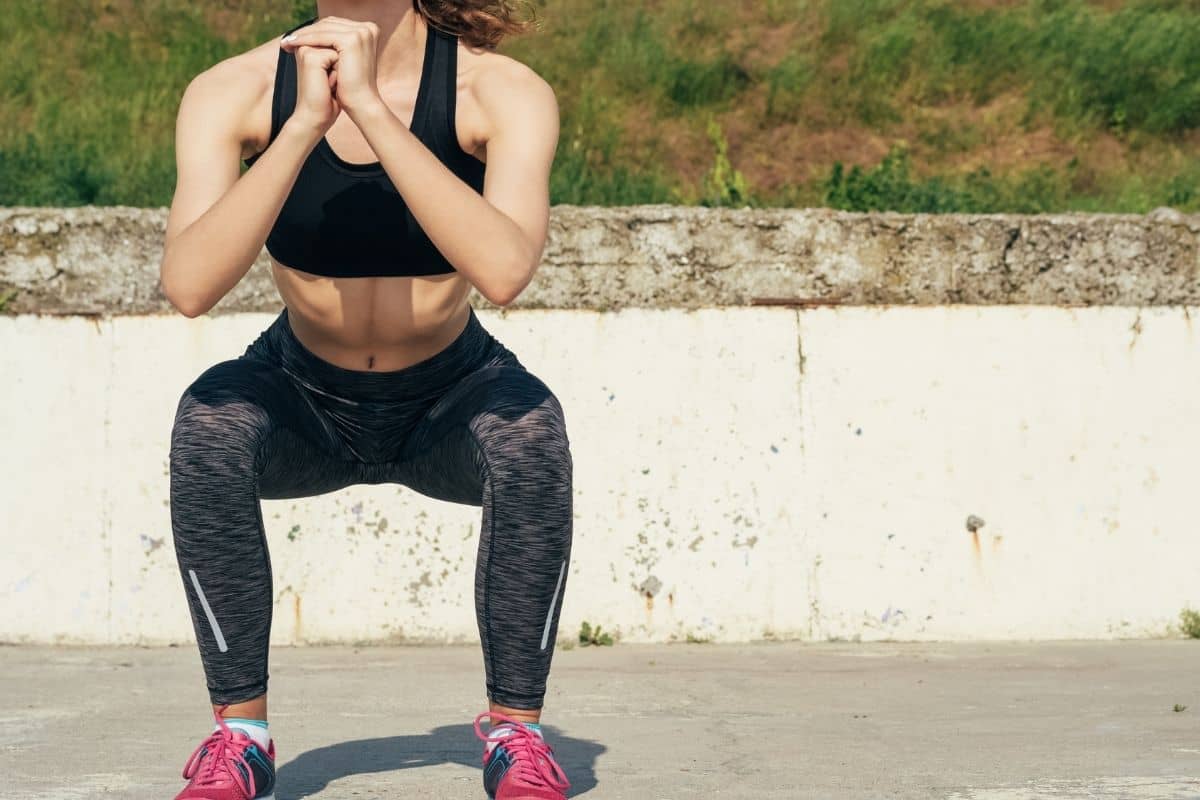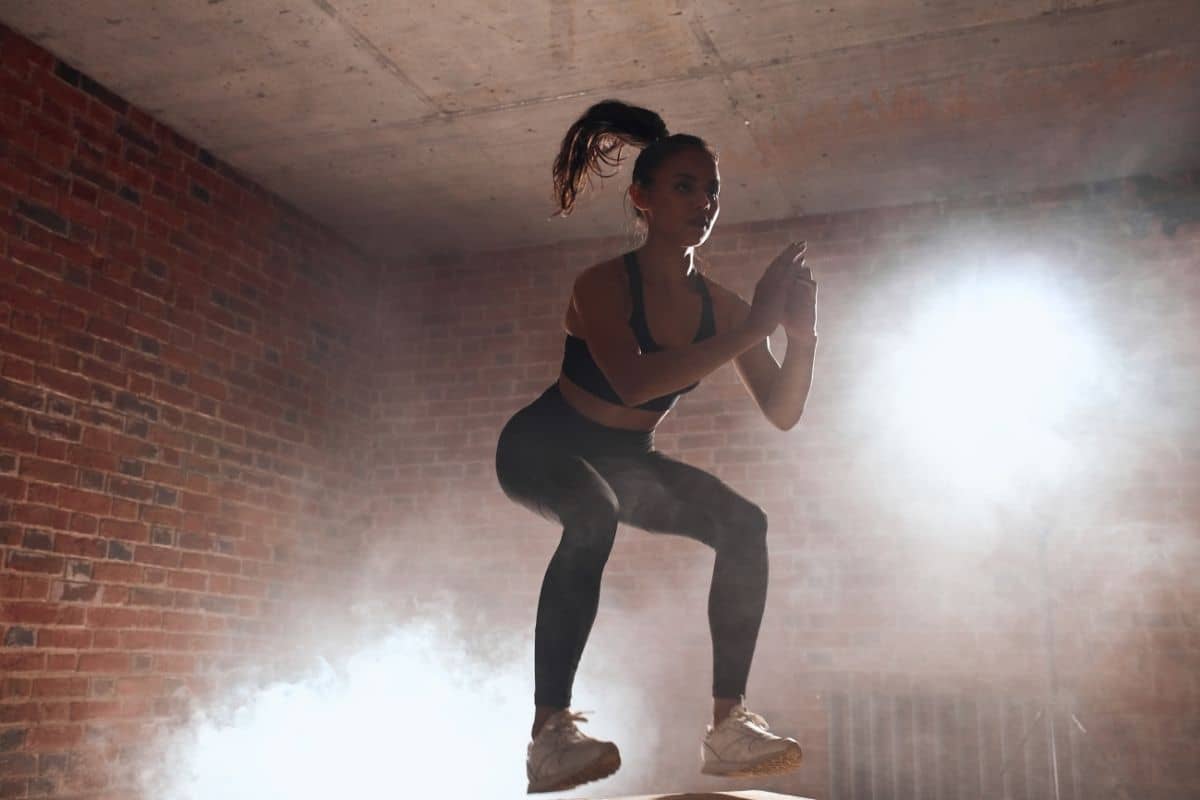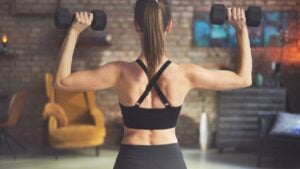Whether you’re a beginner or intermediate, whether you work out at home or in the gym, you can do different types of bodyweight squats to build sturdy legs and glutes.
In this article, I’ve shared as many as 20 best squat variations that require no equipment. These squats will help you target the quadriceps, hamstrings, glutes, and lower back and enhance the lower body muscle development.
Depending on your fitness level, you can integrate some of them into your lower body training program.
20 Best Bodyweight Squat Variations to Sculpt Your Legs at Home
- Goblet Squat
- Sumo Squat
- Jump Squat
- Lateral Squat
- Split Squat
- Pistol Squat
- Single-Leg Squat
- Wall Squat
- Frog Squat
- Prisoner Squat
- Squat with Kickback
- Bulgarian Squat
- Squat to Calf Raise
- Pulse Squat
- Hindu Squat
- Sissy Squats
- Cursty Lunges/Squat
- Pop Squat
- Plie Squat
- Air Squat
Let’s see how to do all the squat variations with step by step guide.
1. Goblet Squat

Primary Target Muscle: Quadriceps
Exercise Benefits: It primarily targets the quadriceps and helps tone and strengthen the legs.
How-to Instructions: Stand straight with your feet shoulder-width apart. Keep your arms bent and hands together against the chest. Slightly push your hips back and squat down while maintaining a flat back. Pause for a moment and then extend your knees to stand up back in the standing position.
Exercise Tips: Maintain a flat back and squat down as far as your mobility allows.
2. Sumo Squat
Primary Target Muscle: Quads and Adductors
Exercise Benefits: It bolsters the inner thighs and adductors and helps build firm and defined legs.
How-to Instructions: Stand straight in the sump stance, toes pointing outward diagonally. Keep your hands at chest level with elbows bent, and start lowering your body by bending your knees and hips at the same time. Go lower until you feel pressure in your inner thigh, then stand back up to complete one rep.
Exercise Tips: Ensure your back is straight and core tight throughout the movement.
3. Jump Squat

Primary Target Muscle: Full Body
Exercise Benefits: The jumping squat is a high-intensity fat-burning exercise that works on the whole body from top to bottom, increases strength and endurance, and improves vertical jump.1 Marián, Vanderka et al. “Improved Maximum Strength, Vertical Jump and Sprint Performance after 8 Weeks of Jump Squat Training with Individualized Loads.” Journal of sports science & medicine vol. 15,3 492-500. 5 Aug. 2016
How-to Instructions: Stand straight with your feet hip-width apart. Lower into a squat and, while returning to the standing position, jump explosively in the air. Softly land again into a squat and repeat. When you jump, your chest will come up and your hands will go backward.
Exercise Tips: Explode upward using your legs and land softly with bent knees.
4. Lateral Squat

Primary Target Muscle: Outer Quads and Adductors
Exercise Benefits: It works on the outer quads and provides a good stretch to the inner thigh as well, helping you improve lower body balance, flexibility, and functional strength for lateral movements.
How-to Instructions: Stand with your feet two times wider than hip-width. Shifting your weight onto the right heel, bend your right knee and squat down while keeping your other leg straight. Slowly return to the standing position and repeat the same with the opposite leg to complete one rep.
Exercise Tips: Maintain a wide, lateral stance with your chest up and back straight.
5. Split Squat

Primary Target Muscle: Quads, Glutes, and Hamstrings
Exercise Benefits: It trains the quads, hamstrings, and glutes, improves lower body strength and muscle balance, and help you do better in activities like running and sports.
How-to Instructions: Stand in the split stance with your feet 10-12 inches apart. Keep your back upright and arms bent against your torso. This is your starting position. Squat down until you reach a seated position. Pause for a second and then press your feet into the ground to stand back. That’s one rep!
Exercise Tips: Avoid letting your front knee beyond the toe.
6. Pistol Squat

Primary Target Muscle: Legs and Glutes
Exercise Benefits: It is an advanced squat variation that requires you to perform a squat using one leg at a time while taking the other leg out. It activates every muscle throughout the lower body and helps build firm and toned legs. The pistol squat also allows you to focus more on your weaker leg and helps fix muscle imbalance.
How-to Instructions: Stand upright with your feet together in the shoulder-width stance and arms straight in front of you. Bend your knees and squat down on your right leg as low as possible. And when you go into the squat position, bring your left leg straight in front of you. Hold in the squat position for as long as you can, and then extend back to the starting position. Repeat with another leg to complete one repetition.
Exercise Tips: Keep your abdominals, glutes, and quads engaged throughout the movement and control the descent and ascent.
7. Single-Leg Squat
Primary Target Muscle: Quadriceps
Exercise Benefits: The single-leg is a unilateral quad exercise that helps you train your legs individually and improve strength and muscle imbalance. It also helps develop balance and flexibility, which helps you perform better during various athletic movements.
How-to Instructions: Stand on your right leg and keep the other one bent with your heel pointing backward. Slowly bend your right knee to squat down while the left leg moves backward. Squat down as low as possible on your right foot and then extend your knees to return to the standing position. Complete desired repetitions and repeat on the opposite side.
Exercise Tips: Lower into a squat in a slow and controlled manner. You can also hold something for support.
8. Wall Squat

Primary Target Muscle: Quads and Glutes
Exercise Benefits: The wall squat is an isometric leg exercise that reinforces the quads and helps develop lower-body muscular endurance and strength.
How-to Instructions: Stand against the wall with your feet together and back resting on the wall. Look forward, keep your core tight, and slowly slide down until your hamstrings parallel to the ground, assuming a seated position. Pause for 10 to 20 seconds. Now, pushing through your feet, return back to the standing position.
Exercise Tips: Keep your chest up and core tight.
9. Frog Squat
Primary Target Muscle: Quads and Hamstrings
Exercise Benefits: The frog squat targets the quads and hamstrings from a different angle and helps build sturdy legs. It also improves hip mobility and makes your lower back slightly flexible.
How-to Instructions: Begin in a wide stance with toes turned slightly outward. Without bending your legs, lean your torso forward. Bend your arms and keep your elbows inside the knees. That’s the start. Bend your knees until you’re in a squat position, chest facing forward. Push through your heels to return to the starting position.
Exercise Tips: Keep your torso bent in the standing position throughout the exercise.
10. Prisoner Squat
Primary Target Muscle: Quadriceps
Exercise Benefits: It is one of the basic squat variations that primarily isolates the quad muscles and builds sculpted legs.
How-to Instructions: Stand straight with your feet shoulder-width apart. Keep your arms bent and hands behind your ears like a prisoner. Now, do as many squats as possible.
Exercise Tips: Ensure your hands are behind your ears throughout the movement.
11. Squat with Kickback
Primary Target Muscle: Legs and Glutes
Exercise Benefits: The squat with kickback is a compound exercise that trains multiple muscles throughout the body, including the quad, glutes, and lower back. It is also a great exercise for people who want to enhance their balance and athleticism.
How-to Instructions: Stand with your feet hip-width apart, holding a dumbbell in front of your chest. Perform a full squat, and when you stand up, squeeze your glutes and kick your right foot behind you while ensuring that your hips stay square to the ground. Pause for a moment, then return to the start.
Exercise Tips: Do more repetitions on the weaker side.
12. Bulgarian Squat

Primary Target Muscle: Thigh and Glutes
Exercise Benefits: The Bulgarian split squat is a great exercise to bolster the glutes and legs from a different angle and helps enhance lower body strength, balance, and muscle definition.
How-to Instructions: Stand upright against the bench (one large step away), place the top of your rear foot on it, and keep your arms straight at your sides. That’s the start. Lower your rear knee toward the ground as you squat down, and go as deep as you can. Pushing through your leading foot, extend your knees to return to the standing position. This is your one rep.
Exercise Tips: Hold your torso straight during the movement and ensure your front knee doesn’t pass the toe while lowering into a squat.
13. Squat to Calf Raise
Primary Target Muscle: Calves and Quads
Exercise Benefits: You can use this squat variation to work on your calves and quads simultaneously. The squat-to-calf raise also improves balance as it requires you to stand on your toes after returning from the squat position.
How-to Instructions: Stand in the shoulder-width stance with your toes slightly turned outward. Lower into a squat until your glutes are parallel to the ground. Pressing through your feet, extend your knees until you’re standing on your toes. Pause for two seconds, then lower your heels on the floor. Complete all repetitions.
Exercise Tips: Make sure to contract your calves at the top for a couple of seconds.
14. Pulse Squat
Primary Target Muscle: Quads and Glutes
Exercise Benefits: Pulse squat is an incredible exercise to increase body temperature and prepare the lower body for intense squat variations, such as squat jump, Bulgarian squat, and unilateral squat.
How-to Instructions: Stand in the shoulder-width stance. Lower into a squat and perform small, controlled pulses, moving up and down an inch or two for as long as possible.
Exercise Tips: Maintain a good posture while doing pulses.
15. Hindu Squat
Primary Target Muscle: Legs and Butt
Exercise Benefits: The Hindu squat is a great way to work on your quads and glutes and tone your lower body. It also engages the various upper body muscles, making it an excellent exercise for warm-up.
How-to Instructions: Stand upright in the hip-width stance. Extend your arms forward. Lower your body by bending your knees and hips while keeping your heels on the ground. Simultaneously, raise your heels and descend deeper, balancing on the balls of your feet. Rise back up to the starting position, extending your arms.
Exercise Tips: You can adjust the distance between your feet.
16. Sissy Squat
Primary Target Muscle: Quads and Knees
Exercise Benefits: The sissy squat is an advanced leg exercise that reinforces the anterior thigh, improves knee stability, and enhances overall balance and muscle coordination.
How-to Instructions: Stand in the normal hip-width stance. Grab something for support. Leaning your torso backward, lower your body (as if you are going to sit on your knees) until your knee touches the floor. Press through your toes and return to the standing position.
Exercise Tips: Keep your abdominal muscles engaged during the exercise and control the descent and ascent.
17. Curtsy Lunges/Squat

Primary Target Muscle: Thighs and Glutes
Exercise Benefits: It bolsters the leg muscles from a different and helps build a firm and flexible lower body. It also helps develop balance and allows you to work more on your inferior leg.
How-to Instructions: Stand straight with your feet together. Cross one leg behind the other at a 45-degree angle, keeping your hips square. Bend both knees, lowering your body as if curtsying. Pause for a moment, then return to the start.
Exercise Tips: Keep your chest up and core engaged throughout the exercise.
18. Pop Squat
Primary Target Muscle: Quads, Glutes, and Hamstrings
Exercise Benefits: The pop squat is a plyometric exercise that strengthens the entire lower body and helps increase jump ability and explosiveness. People who want to burn calories and increase cardiovascular fitness can also include this exercise in their weight loss exercise program.
How-to Instructions: Start straight with your feet together. Lower your body into a squat, keeping your chest up and core engaged. Explosively jump up, extending your legs and spreading them wide. Land softly and immediately go back into a squat position. Continue with this explosive squat-jump movement.
Exercise Tips: Do as many reps as possible, focusing on power and agility.
19. Plie Squat
Primary Target Muscle: Inner Thighs, Glutes, and Adductors
Exercise Benefits: The plie squat is similar to the sumo squat, so their benefits are. The only difference is hand position. During the Sumo, hands are together against your chest, while during the plie squat, your hands are on the sides of your hips.
How-to Instructions: Stand with your feet wider than shoulder-width apart and toes turned outward. Keep your chest up and shoulders relaxed. Lower your body by bending your knees, ensuring they align with your toes. Hold the position for a moment. Push through your heels to return to the starting position.
Exercise Tips: Perform each rep in a controlled fashion, feeling the full contraction.
20. Air Squat
Primary Target Muscle: Quadriceps
Exercise Benefits: It primarily isolates the quads and helps improve leg strength and shape. You’ll often see this squat variation in most CrossFit WODs.
How-to Instructions: Standing in the squat stance, extend your arms in front of your chest so they are parallel to the floor. Now, perform as many reps as possible.
Exercise Tips: Keep your arms straight and parallel to the ground during the entire movement.
Major Benefits of Squat Exercises
Let’s look at all the benefits of squats:
1. Strengthen The Lower Body
Squats are compound movements because they engage many muscles and joints simultaneously, such as the quads, gluteals, hip flexors, hamstrings, calves, knees, feet, and ankles. A firm and flexible lower body helps enhance functional fitness and athletic performance.
2. Burn Calories and Support Weight Loss
Different kinds of squats, such as squat jump, pop squat, air squat, and squat pulses, are excellent for torching significant calories in a short time.
A study published on the National Institute of Health website has shown that 8-week of body mass-based squat exercise training decreased 4.2% percent body fat in adolescent boys.2 Takai, Yohei et al. “Effects of body mass-based squat training in adolescent boys.” Journal of sports science & medicine vol. 12,1 60-5. 1 Mar. 2013
So, whether you’re male or female, you can perform the different bodyweight squat variations to increase weight loss and improve your body composition.
3. Build Lean Mass
The different squat variations target every muscle in the lower body and help increase lean body mass and muscle thickness. (2)
They also help you shape your thighs and glutes appearance and improve muscle definition.
4. Bodyweight Squats are Adaptable
Bodyweight squats require no equipment. You can do them anywhere and at any time, in the comfort of your home, on the beach, and in the mountains.
5. Stimulate Core Muscles
Almost every squat variation requires you to keep your core engaged during the movement, but pistol squats, single-leg squats, sissy squats, and Bulgarian squats highly activate abdominal muscles and strengthen your core.
6. Improve Athletic Performance
Whether you want to increase your jump, enhance your running speed, or improve your overall athletic performance, you can integrate multiple variations of squats into your training program. For example, a high jumper can include a squat jump and squat pulses and runners can incorporate air squats, Bulgarian squats, lateral squats, etc.
7. Lower The Risk of Injuries
The different squats strengthen bones and joints and reduce the risk of injuries. Having strong bones and joints also helps you in the long run and may protect you from the threat of joint pain.
30-Day Squat Challenge to Bolster Legs and Glutes
Days – 1, 6, 11, 16, 21, 26
- 10 Goblet Squats
- 10 Jump Squats
- 10 Lateral Squats (5/leg)
- 10 Split Squats
- As many rounds as possible.
Days – 2, 7, 12, 17, 22, 27
- 10 Pistol Squats
- 5 Wall Squats (5 seconds per rep)
- 10 Frog Squats
- 10 Prisoner Squats
- Repeat as many times as possible.
Days – 3, 8, 13, 18, 23, 28
- 10 Bulgarian Split Squats (5/leg)
- 20 Squat Pulses
- 10 Plie Squats
- 10 Hindu Squats (5/leg)
- Repeat as many times as possible.
Days – 4, 9, 14, 19, 24, 29
- 5 Sissy Squats
- 10 Cursty Squat (5/leg)
- 10 Pop Squats
- 10 Air Squats
- As many rounds as possible.
Days – 5, 10, 15, 20, 25, 30
- 10 Single-Leg Squats (5/leg)
- 10 Sumo Squats
- 10 Squat with Kickback (5/side)
- 10 Squat to Calf Raises
- Repeat for the desired times.
References
- 1Marián, Vanderka et al. “Improved Maximum Strength, Vertical Jump and Sprint Performance after 8 Weeks of Jump Squat Training with Individualized Loads.” Journal of sports science & medicine vol. 15,3 492-500. 5 Aug. 2016
- 2Takai, Yohei et al. “Effects of body mass-based squat training in adolescent boys.” Journal of sports science & medicine vol. 12,1 60-5. 1 Mar. 2013






